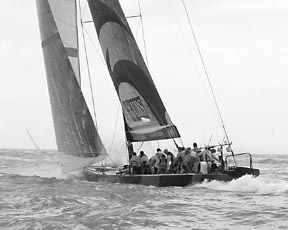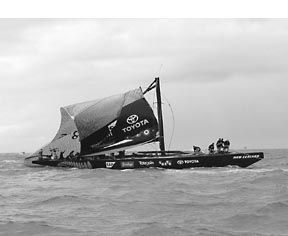What went wrong? How can a team that had won the previous two America’s Cups by a combined score of 10-0 self-destruct in a matter of days, going 0-5 against Swiss challenger Alinghi?

These questions, of course, have no simple answers. Just as overwhelming victory is rarely the result of a single factor, unexpected collapse can result from a series of small, seemingly unimportant flaws that add up to fatal weakness.
Kiwi sailors have frequently used innovative thinking to overcome the natural disadvantage of relatively small budgets or lack of other resources. But innovative thinking does not always give you enough of an edge to make up for other weaknesses.
A case in point was Team New Zealand’ s much-hyped “hula,” a close-fitting hull appendage that short-circuited the class rule prohibiting hollows on the surface of the hull. The pundits—and Team New Zealand themselves—believed that they had found the magic bullet that would give them unbeatable boat speed.
Much of the yachting press—notable exceptions were Marcus Wheatley of the UK and Gary Jobson of ESPN—predicted another TNZ sweep of an overfunded but improperly prepared challenger who had never shown breakaway speed during the challenger trials. Instead, they witnessed the rout of a shockingly ill equipped defender by the most meticulously prepared challenger in the history of the America’s Cup.
Much was made during the challenger selection series of the narrow wind range within which the boats would start a race: 7 to 19 knots. The defenders boasted that they would race in any conditions, with no upper wind limit.
Their bluff was called during the America’s Cup itself.On the first day of the America’s Cup, windspeeds were in the mid-20s, with choppy seas. Five minutes into the race, TNZ was in big trouble.
With the boat heeling excessively in the strong winds, water poured over the side decks, flooding the leeward side of the cockpit.
On these boats, there are many openings in the cockpit sidewalls about eight inches above the cockpit sole, openings designed to lead control lines to belowdecks storage bags. With the boat heeled 35 degrees and the cockpit flooded, water poured below at an astonishing rate.
Loads on every part of the boat increased dramatically with tons of water on board. The end of the innovative TNZ lightweight girder main boom snapped off, making it impossible to flatten the mainsail. The over-full mainsail simply caused the boat to heel even more.

Moments later, the headsail tack ring failed, and the jib blew out of its headfoil. The flailing headsail shook the rig violently.
Team New Zealand dropped out of the race before suffering further damage. Ominously, NZL 81, their tune-up boat, showed signs of structural damage when the two boats returned to the dock, tails between their legs.
When Alinghi returned to the dock, her four primary structural engineers went about their normal routine. Every day of sailing, every single square inch of the boat, from top to bottom, was examined in minute detail by those who knew her best. Nothing, absolutely nothing, was ever left to chance.
In the next two races, in light airs, Alinghi simply outsailed TNZ. The Kiwis showed good boatspeed, but nothing which would suggest breakaway capabilities. The hula was no magic bullet.
After days of delays waiting out strong winds, race four was started in conditions similar to the first day of heavy-air racing. A northeast wind on top of a residual northeast swell saw both boats pitching their bows under before the start.
From my position on an umpire boat, 75 meters away from the racing yachts, it was clearly the kind of day that breaks boats. Someone wasn’t going to finish that day of racing.
Halfway up the second beat, NZL 82 lifted most of her underbody clear of the water on a series of short, steep waves. She slammed down into the third wave, and with a mighty “crack,” her mast splintered above the first spreaders.
For all practical purposes, the America’s Cup was over. The final race, delayed for days due—ironically—to a lack of wind, was an anticlimax. The flawless Alinghi team, led by ex-pat Kiwis Russell Coutts and Brad Butterworth, put on a classic demonstration of match racing, controlling the race from start to finish.
The America’s Cup was en route to Europe, and a shattered Team New Zealand was left to contemplate the folly of putting all their eggs in a single, fragile basket.

































